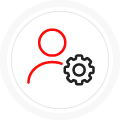LMS FOR EMPLOYEE ONBOARDING
An LMS for employee onboarding helps to induct, train, assess, and successfully integrate new employees into an organization. Onboarding is integral to helping employees start new positions with maximum clarity, ensuring they face minimal challenges during the initial phase.

Industries with high attrition rates conduct regular employee onboarding activities. Diverting critical resources like time, money, and effort towards repeatedly training individuals is inefficient. The resources needed to onboard employees are the same-the number of employees differs.
Covid-19 has exposed organizations overly reliant on face-to-face training or classroom training only, making it difficult to hire and train remotely.
Onboarding remote employees in an era of work-from-home (WFH) is a challenge without an LMS that supports digital learning.
Abara LMS facilitates the creation and storage of courses in a central repository, allowing repeated access to training content. Organizations can onboard individuals or a batch of employees and scale the resources as needed. Moreover, the only resources needed here are LMS accounts!
Hence, stop delaying and justifying the various costs of training, or waiting for a certain number of new employees to join before onboarding. It’s best to train employees (single or in batches) as they arrive on the Abara LMS platform.


WHY DO YOU NEED AN LMS FOR EMPLOYEE ONBOARDING?
WHY DO YOU NEED AN LMS FOR EMPLOYEE ONBOARDING?
Onboarding employees requires repeated allocation of limited resources. Storing onboarding related training content on an LMS makes repeated training simpler. Unhindered access to training content also ensures maximum retention.
Standardized training content ensures standardized employee training. Inconsistent training as a result of unstructured traditional practices, which must be avoided at all costs. Abara structures and standardizes onboarding for all your employees.
Onboarding helps to integrate new employees into your organization’s environment. A detailed look into your organization’s beliefs, expectation, and roadmap is a great place to start. Some key elements of an employee onboarding activity can include:
Vision and mission sharing
History and about the organization
Organization-wide ethics and policies
Introduction to the new role
Information on the product and services of the organization
Compliance training

IMPACT OF COVID-19 ON ORGANIZATIONS
Covid-19 will permanently change the composition of the workforce, from work from an office to remote workers, and from local to regional to even global, especially for knowledge workers who are part of the digital economy.
The unfortunate by product of the Covid-19 slowdown is the massive amount of layoffs and job losses the world over. This is, of course, due to the shock to the economic system. But eventually, employment levels will start to get back and people will need to be rehired and retrained as people move to new industries and companies.


HOW DOES ABARA LMS HELP WITH ONBOARDING?

Central repository
A central repository of digital onboarding-related courses grants automatic access to all new employees.
Pre-recruitment assessment
During the Covid-19 era, the need to screen employees remotely can be done via digital tests and assessments to ensure the selection of new hires who meet the skill and knowledge requirements of the company.
Post-training assessment
Assessments to evaluate the impact of training delivered during onboarding ensures all new employees are ready to start performing on the right note.
Blended learning
On-the-job training (OJT) is blended with eLearning courses to enhance a new employee’s understanding of their job role.
Repeated onboarding
Onboarding employees using a human resource is a thing of the past! Abara LMS provides a cost-effective and efficient way to deliver relevant training.

BENEFITS OF USING ABARA AS AN EMPLOYEE ONBOARDING SOFTWARE
Saves costs of repetitive training
Remotely onboard team members anywhere in the world
No need to hire a trainer or a venue
New hires train at their own pace
Track progress made by all employees
Training is always accessible


TYPES OF COURSES FOR EMPLOYEE ONBOARDING


Company History and Overview Training

Company Policy Training

Product and Services orientation

Workplace Health and Safety Training

On-the-Job Supporting Training
